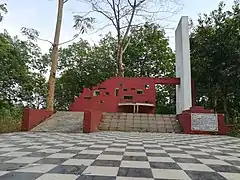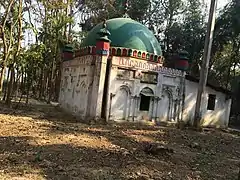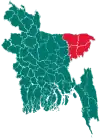Bahubal
বাহুবল | |
|---|---|
._.jpg.webp) Tea garden in Putijuri, Bahubal upazila | |
.svg.png.webp) | |
| Coordinates: 24°21.3′N 91°32.5′E / 24.3550°N 91.5417°E | |
| Country | |
| Division | Sylhet |
| District | Habiganj |
| Area | |
| • Total | 250.65 km2 (96.78 sq mi) |
| Population (2011) | |
| • Total | 197,997 |
| • Density | 790/km2 (2,000/sq mi) |
| Demonym(s) | Bahubali, Bahuboli |
| Time zone | UTC+6 (BST) |
| Website | bahubal |
Bahubal (Bengali: বাহুবল) is an upazila of Habiganj District[1] in the Sylhet Division of Bangladesh.
History
Bahubal was a part of the Tungachhal and Rajpur kingdoms. The last Raja of Tungachhal, Achak Narayan, was defeated in 1303 during the Conquest of Taraf by Syed Nasiruddin and his 12 lascars.[2]
In the 17th century, after Khwaja Usman's departure from Bokainagar Fort, he reached Putijuri in Bahubal. Here, he built a fort at the foot of the Giripal and stationed his brothers, Malhi and Wali, and son, Mumriz in Putia Hill.[1]
দক্ষিণ ভাগ থেকে আইলো মাল, মির মিরাইয়া চায়
Dokkhin bhag theke ailo Mal, mir miraiya chay
A wrestler came from Dakshinbhag, glaring around at everyone
কুদরত মালের ঘুষি খাইয়া গড়াগড়ি যায়
Qudrot Maler ghushi khaiya goragori jay
He got a punch from Qudrot the Wrestler, and went rolling away
The area was historically famous to be the home of fighters and people of physical strength. Famed for sports such as malla-yuddha and lathi khela. One day, a wrestler (Mal) from Dakshinbhag, Moulvibazar, came to this area to fight another wrestler by the name of Qudrat Mal in a game of malla-yuddha. Qudrat defeated the wrestler and made his famous statement, "Bahuka Bol Dekh, Beta". This phrase became famous in the local area and from Bahuka-Bol, the place eventually was shortened to Bahubal. This incident is remembered through a common folk rhyme.[3]
On 20 December 1793, Bahubal became a part of the Lashkarpur District. In 1921, Bahubal was made a thana headquarter.
During the 1950 East Pakistan riots, the village of Silani was attacked at 9 A.M. on 15 February. The mob raised provocative slogans and set fire to many homes. The inhabitants fled to the nearby jungles to save their lives while the others were killed.
Bahubal thana was upgraded to an upazila in 1984.
Geography
Bahubal is located at 24°21′20″N 91°32′30″E / 24.3556°N 91.5417°E. It has a total area of 250.65 km2.
Demographics
| Year | Pop. (000) | ±% |
|---|---|---|
| 1981 | 120 | — |
| 1991 | 137 | +14.2% |
| 2001 | 167 | +21.9% |
| 2011 | 198 | +18.6% |
| 2022 | 219 | +10.6% |
| Source: Bangladesh Bureau of Statistics[4] | ||
According to the 2011 Bangladesh census, Bahubal Upazila had 37,334 households and a population of 197,997. 58,458 (29.52%) were under 10 years of age. Bahubal had a literacy rate (age 7 and over) of 39.77%, compared to the national average of 51.8%, and a sex ratio of 1018 females per 1000 males. 4,045 (2.04%) lived in urban areas.[4] Ethnic population was 8,268 (4.18%), of which Santal were 1,368.[5]
Administration
Bahubal Upazila is divided into seven union parishads: Bahubal, Bhadeshwar, Lamatashi, Mirpur, Putijuri, Satkapan, and Snanghat. The union parishads are subdivided into 146 mauzas and 325 villages.[4]
Education
There are many schools and colleges.
Gallery
 ফয়জাবাদ হিল বধ্যভূমি ও গণকবর ১৯৭১
ফয়জাবাদ হিল বধ্যভূমি ও গণকবর ১৯৭১ Ancient Mirzatula Mosque in the village of Mirjatula, Mirpur Union.
Ancient Mirzatula Mosque in the village of Mirjatula, Mirpur Union.
See also
References
- 1 2 Jayanta Singh Roy (2012). "Bahubal Upazila". In Sirajul Islam; Ahmed A. Jamal (eds.). Banglapedia: National Encyclopedia of Bangladesh (Second ed.). Asiatic Society of Bangladesh.
- ↑ উপজেলার পটভূমি. Government website. Archived from the original on 2020-07-05. Retrieved 2019-11-10.
- 1 2 কুদরত পালোয়ানের ‘বাহুর বল’ থেকে যে উপজেলার নাম. Banglanews24.com (in Bengali). 11 December 2015.
- 1 2 3 4 "Bangladesh Population and Housing Census 2011 Zila Report – Habiganj" (PDF). bbs.gov.bd. Bangladesh Bureau of Statistics.
- ↑ "Community Tables: Habiganj district" (PDF). bbs.gov.bd. Bangladesh Bureau of Statistics. 2011.
